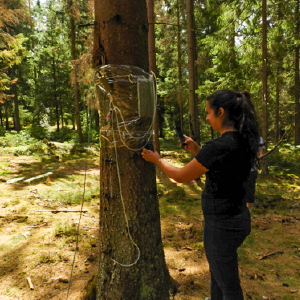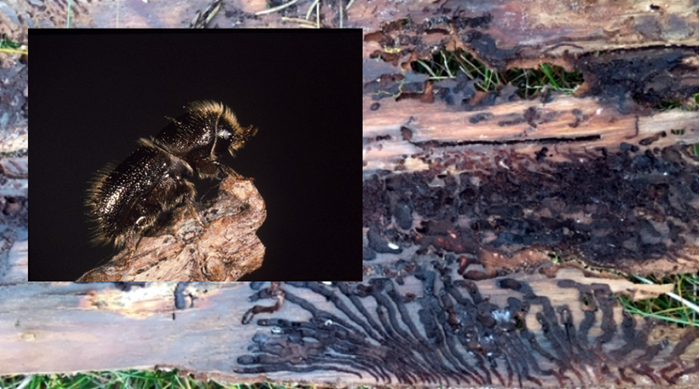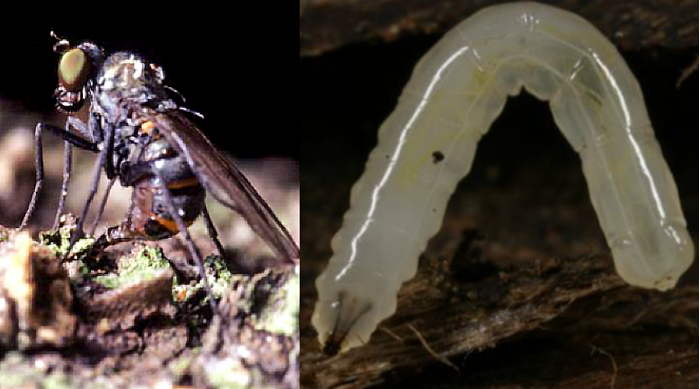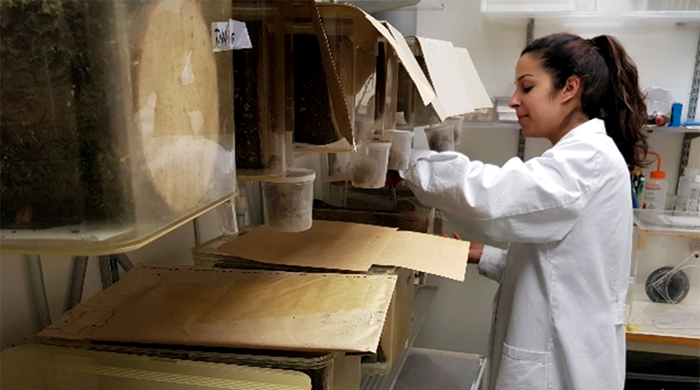The bark beetle, Ips typographus, is a severe insect pest on Norway spruce and reduce timber quality. Harvesting infected timber is a method that is used to get rid of the pest, but this method has problems as the bark beetles may already have moved on to new trees or to soil where most of the bark beetle adults overwinter. Therefore, Maria Sousa is investigating if natural enemies can be used as biological control agents against the bark beetle in her PhD project.
Maria came to Sweden in 2014 to work at SLU with a scholarship where, in collaboration with others PhD students and Post docs, she worked in different projects related to microbe-insect interactions. Previously she finished her master in biochemistry at the University of Madeira in Portugal. In July 2017, she started as a PhD student at SLU. After some parental leave she is back at SLU to continue
– My PhD project focus on the biologic control of Ips typographus. The bark beetle, Ips typographus, is a severe insect pest on mature Norway spruce (Picea abies). When the weather and local forest conditions are favorable, their population can increase and infest/kill large areas of healthy mature standing spruce trees. During the infestation, the beetles construct galleries under the bark of the trees where they feed and reproduce. While constructing these galleries, the beetles also introduce a blue-staining fungi that disseminates through the wood reducing the quality of the timber, says Maria.
Harvesting infected trees is not always a succesful method
In order to reduce bark beetle outbreaks, different control strategies have been used. For example, a common practice here in Sweden involves the harvest of the infested timber. However, this process is effective only if all the infested trees are cut and removed before the adult brood beetles emerge. Most of the times this procedure is done too late so when the timber is removed the beetles are no longer under the bark. On the other hand, the bark beetles’ natural enemies (which are also under the bark of infested trees and emerge few weeks after the beetles) are the ones ending up removed from the forest.
– In this project I am studying one group of bark beetle’s natural enemies, namely the long legged flies (Dolichopodidae) from Medetera genus. The flies have been suggested to be one of the most important biological control agent of bark beetles. The biological control process of bark beetles by Medetera spp is as follows: the fly females identify a tree under bark beetle attack from a distance. After landing, they ”scan” the surface searching for bark beetle galleries. The females oviposit their eggs at the entrances of bark beetle galleries and the enclosed larvae goes into the bark beetle larval galleries, where they predate on the bark beetle brood during their development, says Maria.
"We are learning about their behaviour every day"
– There are two main challenges with my project: the first is that, in general, is very little information available about the flies (ecology, physiology, identification) and that we have never studied specifically these flies in our lab, hence we are learning about their behavior every day. And the second challenge is that these flies can only be field collected during Spring/Summer, so a lot of planning needs to happen to make sure we have a productive season, says Maria.
Medetera larvae – very effective natural enemies
Studies have shown that one Medetera larvae can consume between 5 to 20 individuals depending on bark beetle density and more than ten Medetera larvae can be found per 100 cm2 of attacked bark. Another study has shown that together with pteromalid parasitoids, dolichopodids can account for more than 80% of the bark beetle mortality.
Little is known about the biology and ecology of the larvae
Although the importance of these predators in the biological control of bark beetles have been identified a long time ago, little information is available regarding Medetera biology and ecology. For example, it is not clear how the flies locate a tree under attack, or how they locate their prey underneath the bark.
– The aim of my PhD studies is to understand a bit more the behavior of these predators and how they can be used as biological agent to reduce attacks of bark beetles. I am are currently identifying which odours are used by the fly adults to detect the trees that are being infected by the bark beetles. And in the future I would like to develop an attractive bait in order to monitor Medetera populations and to attract enoughflies to areas were new bark beetles attacks are starting making their outbreaks to collapse.
What is Maria up to when she is not working?
– Family is my (mandatory) hobby. And, when possible, getting a sunbath while listening to the birds singing, says Maria.



